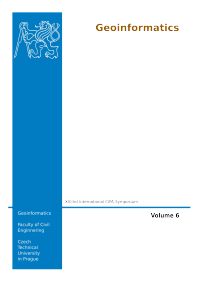Olomouc - Possibilities of Geovisualization of the Historical City
DOI:
https://doi.org/10.14311/gi.6.33Keywords:
Geovisualization, Spatio-temporal change, 3D, 3D map, Fortress, OlomoucAbstract
Olomouc, nowadays a city with 100,000 inhabitants, has always been considered as one of the most prominent Czech cities. It is a social and economical centre, which history started just about the 11th century. The present appearance of the city has its roots in the 18th century, when the city was almost razed to the ground after the Thirty years’ war and a great fire in 1709. After that, the city was rebuilt to a baroque military fortress against Prussia army. At the beginning of the 20th century the majority of the fortress was demolished. Character of the town is dominated by the large number of churches, burgher’s houses and other architecturally significant buildings, like a Holy Trinity Column, a UNESCO World Heritage Site. Aim of this project was to state the most suitable methods of visualization of spatial-temporal change in historical build-up area from the tourist’s point of view, and to design and evaluate possibilities of spatial data acquisition. There are many methods of 2D and 3D visualization which are suitable for depiction of historical and contemporary situation. In the article four approaches are discussed comparison of historical and recent pictures or photos, overlaying historical maps over the orthophoto, enhanced visualization of historical map in large scale using the third dimension and photorealistic 3D models of the same area in different ages. All mentioned methods were geolocalizated using the Google Earth environment and multimedia features were added to enhance the impression of perception. Possibilities of visualization, which were outlined above, were realized on a case study of the Olomouc city. As a source of historical data were used rapport plans of the bastion fortress from the 17th century. The accuracy of historical maps was confirmed by cartometric methods with use of the MapAnalyst software. Registration of the spatial-temporal changes information has a great potential in urban planning or realization of reconstruction and particularly in the propagation of the region and increasing the knowledge of citizens about the history of Olomouc.References
Boer, A., Processing old maps and drawings to create virtual historic landscapes, e-Perimetron, 2010, Vol. 5, No. 2: 49 – 57.
Buchroithner et al., Lenticular Creation of Thematic Multi-Layer-Models, Proceedings of GeoViz Workshop, 2011, Hamburg, Germany.
Carrozino, M. et al., The Immersive Time-machine: A virtual exploration of the history of Livorno, Proceedings of 3D-Arch Conference, 2009, Trento, Italy.
Cartwright, W.E., Using 3D models for visualizing “The city as it might be”, Proceedings of ISPRS Technical Commission II Symposium, 2006, Vienna, Austria.
Fiala J. (2006) Olomoucke promeny 2006, Olomouc, Danal, 2006.
Fischer, R., Olomoucka pevnost a jeji zruseni, Olomouc, 1935.
Google Earth Blog, Animated 3D models in Google Earth. In digital form http://www.gearthblog.com/blog/archives/2010/11/animated_3d_models_in_google_earth.html, 2010
Guidi, G., Frischer, B., Lucenti I., Rome Reborn - Virtualizing the ancient imperial Rome, Proceedings of the 3D Arch Conference, 2007, Trento, Italy.
Haeberling, Ch., 3D Map Presentation – A Systematic Evaluation of Important Graphic Aspects, Proceedings of ICA Mountain Cartography Workshop "Mount Hood", 2002, Mt. Hood, Oregon, USA.
Haeberling, Ch., Cartographic design principles for 3D maps – A contribution to cartographic theory, Proceedings of ICA Congress Mapping Approaches into a Changing World, 2005, A Coruna, Spain.
Jung K., Kim K.I., Jain A.K., Text information extraction in images and video: a survey. Pattern Recognition, 2004, Volume 37, Issue 5: 977-997.
Keates, J. S., Understanding Maps, London, Longman, 1982.
Kim, H.K., Efficient automatic text location method and content-based indexing and structuring of video database. J. Visual Commun. Image Representation, 1996, 74: 336–344.
Kubicek P., Kozel J., Cartography Techniques for Adaptive Emergency Mapping. Proceedings of Risk Models and Applications Conference, 2010, Berlin, Germany.
Kupka, V., Kuch-Breburda, M., Pevnost Olomouc, Dvur Kralove nad Labem , FORTprint, 2003.
Langweiluv model Prahy, In digital form: http://www.langweil.cz/.
Niederoest, J., A bird’s eye view on Switzerland in the 18th Century: 3D recording and analysins of a historical relief model, Proceedings of the CIPA conference, 2005, Antalaya, Turkey.
Petrovic, D., Masera P., Analysis of user’s response on 3D cartographic presentations, Proceedings of 5th ICA Mountain Cartography Workshop, 2006, Bohinj, Slovenia.
Remondino, F. et al. 3D virtual reconstruction and visualization of complex architectures – The “3D-ARCH” Project, Proceedings of the 3D-ARCH conference, 2009, Trento, Italy.
Swiss Federal Office of Topography (2004) Atlas of Switzerland. Interactive and Multimedia CD-ROM. Ed. Swisstopo, Wabern, Switzerland.
Swiss World Atlas interactive (2010) In digital form: http://www.schweizerweltatlas.ch/en.
Wells, S. Rome Reborn in Google Earth, In digital form http://www.romereborn.virginia.edu/rome_reborn_2_documents/papers/Wells2_Frischer_Rome_Reborn.pdf.
Zatloukal R., Olomoucka pevnost ve svetle archeologickych nalezu, Olomouc Fortess, 2004.
Zebedin, L. et al., Towards 3D map generation from digital aerial images. ISPRS Journal of Photogrammetry and Remote Sensing, 2006, Volume 60, Issue 6: 413-427.
Downloads
Published
Issue
Section
License
- Authors retain copyright and grant the journal right of first publication with the work simultaneously licensed under a Creative Commons Attribution License that allows others to share the work with an acknowledgement of the work's authorship and initial publication in this journal.
- Authors are able to enter into separate, additional contractual arrangements for the non-exclusive distribution of the journal's published version of the work (e.g., post it to an institutional repository or publish it in a book), with an acknowledgement of its initial publication in this journal.
- Authors are permitted and encouraged to post their work online (e.g., in institutional repositories or on their website) prior to and during the submission process, as it can lead to productive exchanges, as well as earlier and greater citation of published work (See The Effect of Open Access).

